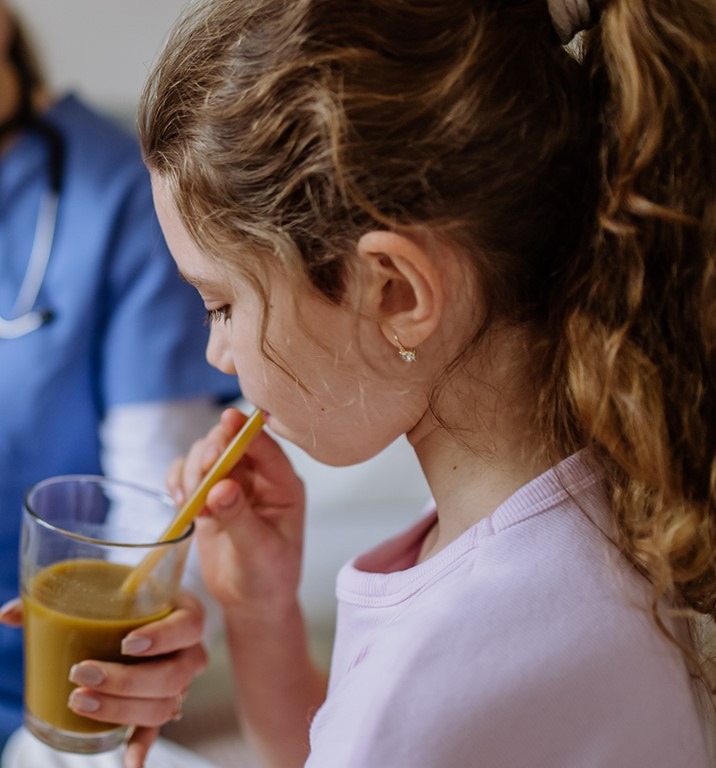NHD Paediatric Hub
Oral nutritional supplements (ONS) in paediatrics: a useful guide
ONS can be used in a wide variety of clinical situations, but it is important that as dietitians we understand the best way to use them and the limitations they have. ONS can be used in children with, or at risk of, faltering growth. They can be used alongside oral intake and consist of products, mainly drinks, taken by mouth to fortify the current dietary intake and optimise growth.(1,2)

There is a growing variety of supplements on the market now for paediatric patients: 1kcal/ml, 1.5kcal/ml, 2.4kcal/ml, with orwithout fibre and based on whole protein or hydrolysed protein. Throughout this article and through the case studies included, we will review the rationale behind which supplement best meets the patient’s needs.
ONS can benefit the child who needs additional nutrients to promote growth.(1-3) ONS can also be used as a sole source of nutrition in medical conditions such as Crohn’s disease.(4) ONS can be used to supplement diets for a wide variety of medical conditions, such as neurological conditions, cystic fibrosis and allergies. The clinical condition can at times dictate the supplement used.
Case study 1: Patient A
Gender: Male
Age: 4 years
Medical Background: Reflux as an infant, reduced oral intake, still vomits 3-4 times per week
Anthropometry: Weight dropped 75th centile to 9th centile over a 2-month period
Nutritional diagnosis: Faltering growth due to restricted intake and oral aversion/sensory issues
BACKGROUND
Patient A was referred to paediatric dietetics due to concerns about faltering growth. A had been born at term and completed weaning appropriately. Throughout the first two years of weaning, he ate a wide variety of foods and textures and his diet was unrestricted. A had reflux as an infant, so had a trial of milk-free formula. Symptoms persisted but a diagnosis of cow's milk protein allergy was not felt appropriate. From the age of around 2.5 years, A’s diet became increasingly restricted and is currently limited to five foods. As a result of his reduced intake, his weight has faltered and anxiety is high in the family.
Following dietetic assessment, a decision was made to start A on ONS to increase calorie intake and promote catch-up growth. The decision was made to start an energy-dense low-volume supplement of 125ml once daily (providing 300kcal, 12g protein). Advice was given to use this pre-bedtime following dinner, to try to reduce the impact on oral intake. An energy-dense low-volume formula was used to keep volume low and promote intake of other foods. this will also prevent satiety from supplements whilst maximising calories, protein and micronutrient content.

Case study 2: Patient B
Gender: Female
Age: Referral at 4 months of age
Medical background: Cardiac arrest age 6 weeks, RSV positive, now recovered, however continues to have increased work breathing and has a cough
Anthropometry: Born 75th centile, adm to PICU weight was just below 75th centile, discharge PICU 50th centile, since then has fallen through centiles and now below 0.4th centile
Nutritional diagnosis: Faltering growth
BACKGROUND
Patient B was referred due to weight faltering, this was felt to be due to increased requirements (increased work of breathing and constant cough) and reduced intake due to reflux and vomiting post feeds. Patient B was breastfed until admission to the intensive care unit when she transitioned to stage 1 infant formula. it was difficult to get an accurate feeding history from Mum – she was feeding constantly as B refused to take any more than 30ml per feeding session. Mum was making a fresh bottle every two hours but reported the bottles were never finished.
In view of the poor growth and vomiting, the decision was made to commence a high-energy infant formula (1kcal/ml). A feeding plan was discussed and it was agreed we would aim for three hourly feeds x eight per day. Mum would keep a diary documenting intake. Feed thickener was added to bottles to try to reduce vomiting and omeprazole was commenced by the medical team. Omeprazole is an acid suppressor, which will reduce the acid content of the stomach, meaning that any reflux should be less painful. The decision was made to make multiple changes in view of the severity of the weight loss.
B returned after two weeks for weight check. Weight gain over the two-week period was 350g with an improvement in growth velocity. B was feeding better and Mum was managing to stick to the three-hourly feed volumes. Mum felt the feed thickener only increased constipation and, therefore, stopped. This had no impact on vomiting/reflux. Despite the weight gain, B continued to vomit, although she was not as distressed with vomits since commencing omeprazole. The decision was made at this point to discuss early weaning alongside the high-energy formula and omeprazole to promote growth and minimise symptoms of reflux.

Case study 3: Patient C
Gender: Male
Age: 14 years 7months
Medical background: New diagnosis Crohn’s disease
Anthropometry: Minimal historical data available, current weight 0.4th centile, height 25th centile. Mum and child reported weight loss of around 8kg prior to review
Nutritional diagnosis: For exclusive enteral nutrition to promote remission Crohn’s disease following recent diagnosis
BACKGROUND
Patient C was referred to dietetics following recent investigation for Crohn’s disease. Pathology has confirmed Crohn’s disease and C has to commence exclusive enteral nutrition (EEN) to induce remission. A growing body of evidence supports the use of polymeric feeds to induce remission in Crohn’s disease. Feeds can be standard 1kcal/ml or 1.5kcal/ml and should not contain fibre. Milk-based supplements are preferred over juice-based, as these are nutritionally complete. Patient C's requirements were calculated with an adjustment for reported weight loss and a volume of ONS was recommended daily. The plan was for this to be taken orally and to try and improve compliance.
C was provided with a plan of taking a set volume six times daily to provide his full intake by the end of the day. Drinks were advised to be consumed over 15 to 20 minutes and each drink to be completed by the end of the ‘mealtime’ to optimise compliance. Patient C liked the variety of the flavours the supplements offered and felt this improved compliance and tolerance.

Conclusion
ONS have an important role in paediatric dietetic management. They can be used in a variety of clinical situations, to supplement oral intake or as a sole source of nutrition depending on the clinical rationale for using them. There is a growing variety of ONS available, including with or without fibre, hydrolysed protein = low-volume and high-calorie, and suitable for infants all the way up to adulthood, depending on the supplement chosen.
As dietitians, our role is to provide a food-first approach, but when ONS is required, we are there to advise regarding the most appropriate supplement to meet the patient’s needs without any detrimental impact. We should be aware of the variety of supplements available and the clinical situations in which they can be used.

Instagram: kidsnutritionrd
Website: www.kids-nutrition.com
Hazel Duncan, RD
Paediatric Dietitian, Kids Nutrition
References
- Zhang Z et al (2021). Effect of oral nutritional supplementation on growth in children with undernutrition: A systematic review and meta‐analysis. Nutrients.; 13(9).
- Huynh D, et al. (2015). Longitudinal growth and health outcomes in nutritionally at-risk children who received long-term nutritional intervention. J Hum Nutr Diet.; 28(6): 623–35
- Hubbard G et al (2020). Energy-dense, low-volume paediatric oral nutritional supplements improve total nutrient intake and increase growth in paediatric patients requiring nutritional support: results of a randomised controlled pilot trial. Eur. J. Pediatr.; 179(9): 1421–30
- Ashton JJ, Gavin J, Beattie RM. Exclusive enteral nutrition in Crohn's disease: Evidence and practicalities. Clin Nutr. 2019 Feb;38(1):80-89. doi: 10.1016/j.clnu.2018.01.020. Epub 2018 Feb 15. PMID: 29398336
